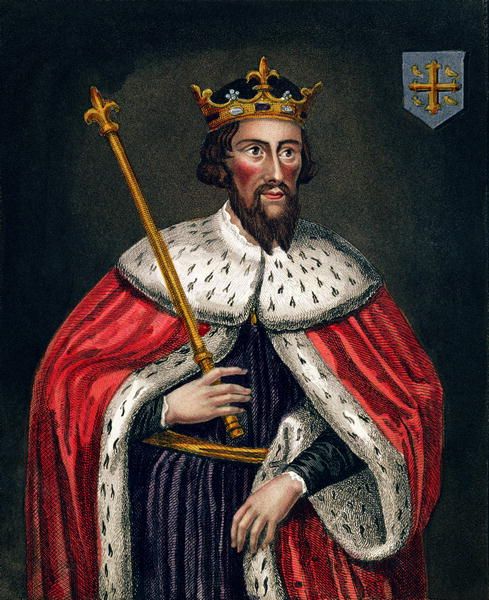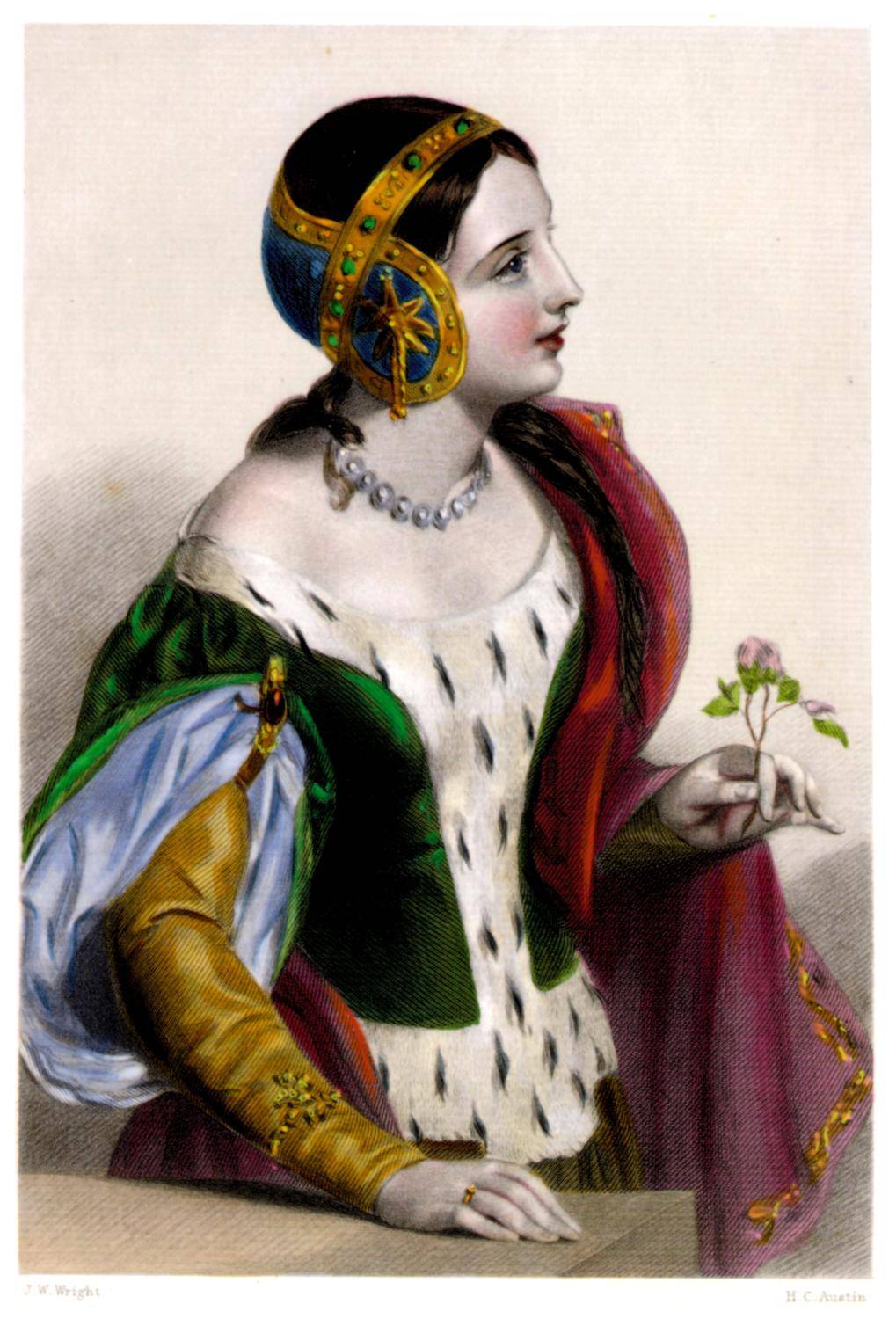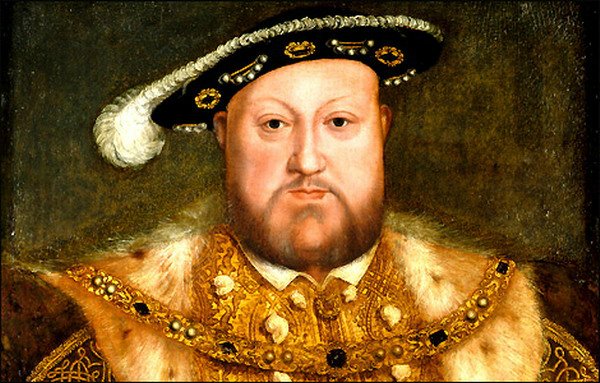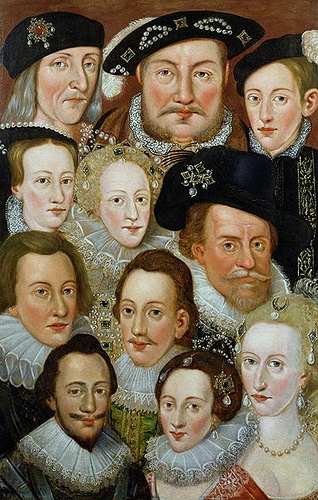Name: King Alfred the Great
Born: c.849 at Wantage, Berkshire
Parents: Aethelwulf and Osburh
Relation to Elizabeth II: 32nd great-grandfather
House of: Wessex
Became King: 871
Married: Ealhswith of Mercia
Children: 5 children, Aelfthryth, Aethelflaed, Aethelgifu, Edward, Aethelweard
Died: October 26, 899
Buried at: Winchester
Succeeded by: his son Edward
Anglo-Saxon king 871–899 who defended England against Danish invasion and founded the first English navy. He succeeded his brother Aethelred to the throne of Wessex in 871, and a new legal code came into force during his reign. He encouraged the translation of scholarly works from Latin (some he translated himself), and promoted the development of the Anglo-Saxon Chronicle. This ensured that his deeds were recorded in history as legends and we know more about him than any other Anglo Saxon King.
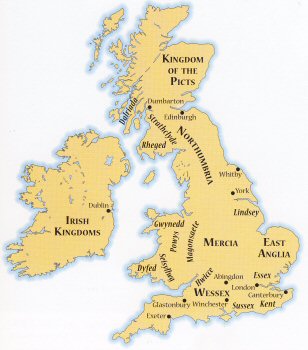 Alfred was born at Wantage, historically in Berkshire but currently in Oxfordshire, the youngest son of Aethelwulf (d. 858), king of the West Saxons. In 870 Alfred and his brother Aethelred fought many battles against the Danes. Alfred gained a victory over the Danes at Ashdown in 871, and succeeded Ethelred as king in April 871 after a series of battles in which the Danes had been defeated. Not all his campaigns were so successful; on a number of occasions he had to resort to buying off the Danes for a brief respite. Five years of uneasy peace followed while the Danes were occupied in other parts of England. In 876 the Danes attacked again, and in 878 Alfred was forced to retire to the stronghold of Athelney which was at that time an island in the Somerset Levels. The legend of him burning the cakes probably comes from this period.
Alfred was born at Wantage, historically in Berkshire but currently in Oxfordshire, the youngest son of Aethelwulf (d. 858), king of the West Saxons. In 870 Alfred and his brother Aethelred fought many battles against the Danes. Alfred gained a victory over the Danes at Ashdown in 871, and succeeded Ethelred as king in April 871 after a series of battles in which the Danes had been defeated. Not all his campaigns were so successful; on a number of occasions he had to resort to buying off the Danes for a brief respite. Five years of uneasy peace followed while the Danes were occupied in other parts of England. In 876 the Danes attacked again, and in 878 Alfred was forced to retire to the stronghold of Athelney which was at that time an island in the Somerset Levels. The legend of him burning the cakes probably comes from this period.
His come back and great victory at Edington in 878 secured the survival of Wessex, and the Treaty of Wedmore with the Danish king Guthrum in 886 established a boundary between the Danelaw, east of Watling Street, and the Saxons to the west. The Anglo-Saxon Chronicle says that following his capture of London in 886 ‘all the English people submitted to him, except those who were in captivity to the Danes’. In some respects, therefore, Alfred could be considered the first king of England. A new landing in Kent encouraged a revolt of the East Anglian Danes, which was suppressed 884–86, and after the final foreign invasion was defeated 892–96, Alfred strengthened the navy to prevent fresh incursions.
During periods of peace Alfred reformed and improved his military organization. He divided his levies into two parts with one half at home and the other on active service, giving him a relief system he could call on to continue a campaign. He also began to build burhs (fortified strongpoints) throughout the kingdom to form the basis of an organized defensive system. Alfred is popularly credited as being the founder of the Royal Navy; he did build a fleet of improved ships manned by Frisians and on several occasions successfully challenged the Danes at sea.
No other ruler in England’s long and varied history has been honoured with the title the Great. Alfred once declared it his intention “To live worthily as long as I live and after my life to leave to them that should come after, my memory in good works.” Few of our monarchs have succeeded as spectacularly in their aims as he did.
Early Life
Alfred (Old English-Aelfred) was the fifth and youngest son of Ethelwulf of Wessex and his Jutish first wife, Osburh. He was born at Wantage between 847 and 849, his birthplace was a palace or vill which lay at the foot of the Berkshire Downs, which has now vanished. Ill health is reported to have marred Alfred’s childhood.
Described by Asser as ‘ loved by his father and mother, and even by all the people, above all his brothers, and was educated altogether at the court of the king. As he advanced through the years of infancy and youth, his form appeared more comely than that of his brothers; in look, in speech, and in manners he was more graceful than they. His noble nature implanted in him from his cradle a love of wisdom above all things; but, with shame be it spoken, by the unworthy neglect of his parents and nurses, he remained illiterate even till he was twelve years old or more; but, he listened with serious attention to the Saxon poems which he often heard recited, and easily retained them in his docile memory. He was a zealous practiser of hunting in all its branches, and hunted with great assiduity and success; for skill and good fortune in this art, as in all others, are among the gifts of God, as we also have often witnessed.’
One of the few stories that survive from Alfred’s early life relates that his mother, Osburh, showed her sons a beautifully illuminated volume of Saxon poetry and promised to make a gift of it to the first of them who was able to read it. Alfred quickly learned to read it aloud, and was made a gift of the book when he was only six years old. His youngest son appears to have been Ethelwulf’s favourite, his father took Alfred on pilgrimage to Rome, to receive the blessing of his godfather, Pope Leo IV. It was rumoured that King Ethelwulf wished to make Alfred his successor.
On Ethelwulf’s return to England he found his eldest son, Ethelbald, had usurped his throne in his absence. Nobly accepting the status quo in the hope that civil war and the consequent loss of life could be avoided, Ethelwulf retired to Kent, where he reigned as sub-king until his death in 858. Alfred was around eleven when his father died. He was studious as a child and grew to be a man of determination, intelligence and resolution, despite suffering from ill health for much of his life.
Alfred’s three elder brother’s reigned in turn before him. During the reign of the youngest of these, Ethelred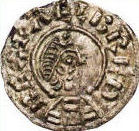 I , Alfred emerges from the mists of obscurity to fight loyally by his side in the struggle against the Danish incursions into Wessex. At the Battle of Ashdown, in the Vale of the White Horse, the pious Ethelred remained so long in his tent praying for victory that Alfred became impatient and lead his men in a furious charge at the enemy without waiting for his brother to finish his prayers.
I , Alfred emerges from the mists of obscurity to fight loyally by his side in the struggle against the Danish incursions into Wessex. At the Battle of Ashdown, in the Vale of the White Horse, the pious Ethelred remained so long in his tent praying for victory that Alfred became impatient and lead his men in a furious charge at the enemy without waiting for his brother to finish his prayers.
The Conflict with the Danes
The Witangemot, or Saxon council of wise men, met after Ethelred’s death from wounds sustained in battle and elected the twenty-two year old Alfred, who had already demonstrated himself a confident leader of men, as King. His brothers between them, had lasted barely a decade. In electing Alfred king the Witan passed over the two young sons of Ethelred. The law of primogeniture was not then established in Saxon England and it was normal practice for the King to be elected in this manner. The practice of crowning a successor as royal prince and military commander is well-known among Germanic tribes.
The depressing series of defeats at the hands of the Vikings continued unabated and Alfred was forced into a strategy of buying them off. As a result they ceased their attacks and for a period of five years, peace reigned in Wessex. This peace was not likely to last for any considerable length of time and was at best a temporary measure. The Viking army, after taking Mercia, divided. One part, under Halfdan, marched north to Yorkshire where they settled permanently. The other, under Guthrum, launched another attack on Wessex in 875. They withdrew again in 877 and began to colonise Mercia.
Wessex was savagely attacked for the third time in 878 and Alfred was driven into hiding at Athelney in the Somerset marshes, he remained there with his ally, Athelnoth, Ealdorman of Somerset and others of his thegns, and biding his time, legend has it that in his preoccupation with the defence of his kingdom, he famously burnt the cakes and was set upon by an angry housewife.
Bishop Asser informs us that Alfred had a great love of jewelled ornaments. His crown, which unfortunately no longer survives, is listed in an inventory of jewels melted down by Oliver Cromwell at the establishment of the Protectorate, it is described as being studded with emeralds.
The Alfred Jewel
In 1693, a remarkable discovery of a Saxon jewel was made at North Petherton near Athelney, in Somerset, now known as the Alfred Jewel. As the Jewel contains no fastening, it is not thought to be a brooch or a clasp. It is probable that it formed the crown of a writing instrument.
The Alfred jewel made of gold and enamel, bears the Anglo – Saxon inscription ‘Aelfred mec heht gewyrgan’ (Alfred had me made)
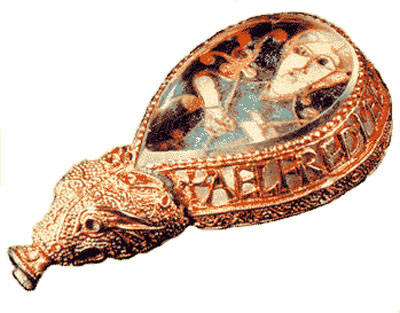 The Alfred Jewel is about 2 and a half inches (6.4 cm) long and was made of filigreed gold, enclosing a highly polished tear-shaped piece of clear quartz ‘rock crystal’, beneath which is set a cloisonné enamel plaque, with an image of a man, perhaps Christ, with ecclesiastical symbols. An animal head at its base has as its snout a hollow socket, showing that it was intended to hold a thin rod or stick. The back is a flat gold plate engraved with an acanthus-like plant motif.
The Alfred Jewel is about 2 and a half inches (6.4 cm) long and was made of filigreed gold, enclosing a highly polished tear-shaped piece of clear quartz ‘rock crystal’, beneath which is set a cloisonné enamel plaque, with an image of a man, perhaps Christ, with ecclesiastical symbols. An animal head at its base has as its snout a hollow socket, showing that it was intended to hold a thin rod or stick. The back is a flat gold plate engraved with an acanthus-like plant motif.
It seems to have been one of the precious ‘æstels’ or staffs that Alfred is recorded as having sent to each bishopric along with a copy of his translation of Pope Gregory the Great’s book Pastoral Care, saying in his preface to the book-“And I will send a copy to every bishop’s see in my kingdom, and in each book there is an aestel of 50 mancusses and I command, in God’s name, that no man take the staff from the book, nor the book from the church”.
The jewel is now housed in the Ashmolean Museum at Oxford
IN 886, Alfred garnered his resources and managed to retake the city of London, but Viking raids continued. At the battle of Ethendun in 878, Saxon forces soundly defeated the Vikings lead by Guthrum and peace was concluded by the terms of the Treaty of Wedmore. Guthrum converted to Christianity with Alfred standing as godfather to his erstwhile enemy. Alfred accepted the Danish colonisation of much of England. A line was drawn which ran north-westwards from London to Chester, defining an area north of this line which was termed the Danelaw.
Alfred improved his army, making provision for it to be always availiable at short notice to defend Wessex. Part of the army was always kept in reserve in case of emergency. The navy was similarly improved, building ships which were bigger and better than those possessed by the Vikings.
King Alfred built up defences and fortified townships to ensure the safety of his people. He established defended settlements, or burhs (from which derives the modern borough) These settlements were recorded in detail in the Burghal Hidage. A network of burhs was established to ensure that no part of Wessex was further than 20 miles from these strongholds. By 897 he had successfully halted the advance of the Vikings, a remarkable achievement.
Peacetime Achievements
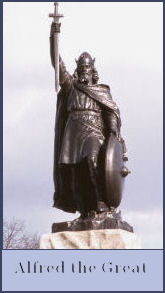 The King turned his attention to the deterioration of learning in England. Due to the continued pillage of monasteries by the Vikings, which essentially formed a network of rudimentary education at the time, educational standards had diminished. Alfred founded a court school to educate the nobles and encouraged the great scholars of his day to take up residence in England. “It is most needful for men to know” he is recorded as stating “and to bring it to pass, if we have peace, that all the youth now in England-may be devoted to learning.” The royal court was to become a magnet for scholars.
The King turned his attention to the deterioration of learning in England. Due to the continued pillage of monasteries by the Vikings, which essentially formed a network of rudimentary education at the time, educational standards had diminished. Alfred founded a court school to educate the nobles and encouraged the great scholars of his day to take up residence in England. “It is most needful for men to know” he is recorded as stating “and to bring it to pass, if we have peace, that all the youth now in England-may be devoted to learning.” The royal court was to become a magnet for scholars.
On the insistence of the King, English became the official written language. Alfred personally translated into English ‘The History of the Venerable Bede’, ‘Boethius’s Consolation of Philosophy’, ‘Dialogues of Gregory the Great’, Gregory’s ‘Pastoral Care’. and Orosius’ Soliloquies of St. Augustine’. Prior to this, all books had been written in Latin.
Alfred is also noted for beginning the Anglo-Saxon Chronicle in the 890’s and had many copies made. The chronicle was written in Anglo-Saxon, rather than the usual Latin. Alfred decreed that these copies be placed in monasteries and churches and frequently updated. The chronicle was updated until the twelfth century, some of the original copies still survive to the present day. It remains one of the few literary sources we possess for English history from the departure of the Romans to the Norman conquest.
Alfred established a legal code, forming a body of Saxon law, based on the laws of Offa of Mercia, which limited the practice of blood feuding and imposed heavy penalties on those in breech of sworn oath.
“I … collected these together and ordered to be written many of them which our forefathers observed, those which I liked; and many of those which I did not like I rejected with the advice of my councillors … For I dared not presume to set in writing at all many of my own, because it was unknown to me what would please those who should come after us … Then I … showed those to all my councillors, and they then said that they were all pleased to observe them” (Laws of Alfred, c.885-99).
Throughout his life, Alfred had suffered from a mysterious illness, about which little is known with certainty, but which left him incapacitated for long periods. This is one of the most puzzling and often discussed areas of Alfred’s life. Bishop Asser informs us that Alfred suffered bouts of depression after each attack. The first attack apparently occured at his wedding. Asser describes Alfred’s symptoms, terrible intermittent pains, difficulty riding a horse, it is now hypothesised that his illness may have been Crohn’s Disease, which may have been inherited by his grandson King Edred.
The Death of Alfred
Alfred died at Wantage in 899 at the age of fifty-three. He remains the only English sovereign ever to be given the epithet the Great, which was bestowed on him in the seventeenth century.
The fame and reputation of King Alfred, one of the ablest of England’s Kings, were never to diminish. Florence of Worcester, writing in the thirteenth century, has left us with a fitting statement on Alfred:-
“Alfred the King of the Anglo-Saxons, the son of the most pious King Ethelwulf, the famous, the warlike, the victorious, the careful provider for the widow, the helpless, the orphan and the poor, the most skilled of Saxon poets, most dear to his own nation, courteous to all, most liberal, endowed with prudence, fortitude, justice and temperance; most patient in the infirmity from which he continually suffered; the most discerning investigator in executing justice, most watchful and devout in the service of God.”
 Many of our Kings could not wish for a finer epitaph.
Many of our Kings could not wish for a finer epitaph.
King Alfred was buried in the Old Minster at Winchester but a few years later, on the completion of the New Minster, which Alfred had founded, his body was translated there, it was soon to be named Hyde Abbey. On the Dissolution of the Monasteries, Hyde Abbey, in common with other religious houses was despoiled and in an act of historical vandalism, the tombs of the Saxon kings were destroyed.
An application has recently been made to exhume and study bones believed to lie in an unmarked grave at St Bartholomew Church in Winchester, Hampshire, to discover if they are the those of King Alfred. in 1538, during King Henry VIII’s dissolution of the monasteries, Hyde Abbey was ransacked and destroyed, leading to the mystery over the whereabouts of Alfred’s remains. Tradition states that the graves of Alfred and his family were not disturbed, but were unearthed during later pilfered during construction of the town jail in 1788. A vicar reputedly bought the bones. An excavation carried out in the 1990’s confirmed where the tombs once were and slabs now mark the spot. The University of Winchester is attempting to obtain permission from a diocesan advisory panel of the Church of England which will consult English Heritage. A judge will make a final decision. DNA testing on bones of this age would be extremely difficult, German scientists analysed the skeleton of Alfred’s granddaughter Eadgyth in Magdeburg, to get DNA, which proved unsuccessful, so experts are hoping to rely on radio carbon dating to obtain proof.
| Timeline for King Alfred the Great |
| 871 | Alfred becomes King of Wessex following the death of his brother Aethelred |
| 872 | London falls to Viking raiders |
| 875 | After persistent attacks by Vikings the monks of Lindesfarne travel through Northumbria and Galloway with the Lindesfarne Gospels. |
| 878 | Guthrum’s Danish army invades Wessex, and Alfred takes refuge on the isle of Athelney. Alfred defeats Guthrum at the battle of Ethandune (Edington) in Wiltshire. |
| 878 | Treaty of Wedmore divides England into two. Guthrum accepts baptism as a Christian and agrees to leave Wessex and settle in East Anglia. |
| 884 | Alfred defeats the Danes at Rochester |
| 885 | Alfred imposes rules on South Wales |
| 886 | Alfred takes London from the Danes. Danelaw – the territory occupied by the Danes in East Anglia is recognised by Alfred |
| 890 | Guthrum dies. Alfred establishes a permanent army and navy |
| 891 | Anglo Saxon Chronicle, source of much early British History, begun |
| 893 | Asser, Bishop of Sherborne, completes his book The Life of Alfred the Great |
| 894 | Northumbrian and East Angles swear allegiance to Alfred, but promptly break the truce attacking South West England. |
| 896 | Naval victory over the Danes in the Solent |
| 899 | Alfred dies and is buried at Winchester. His son Edward becomes king. |
Credits:
http://www.britroyals.com/
http://www.englishmonarchs.co.uk/

